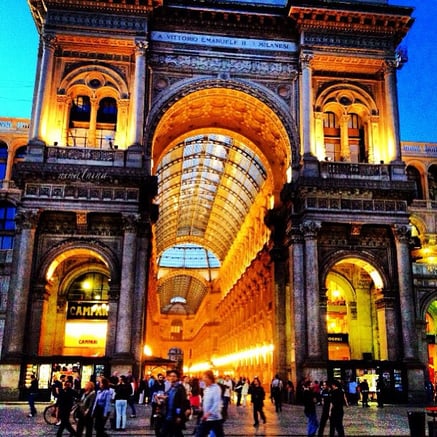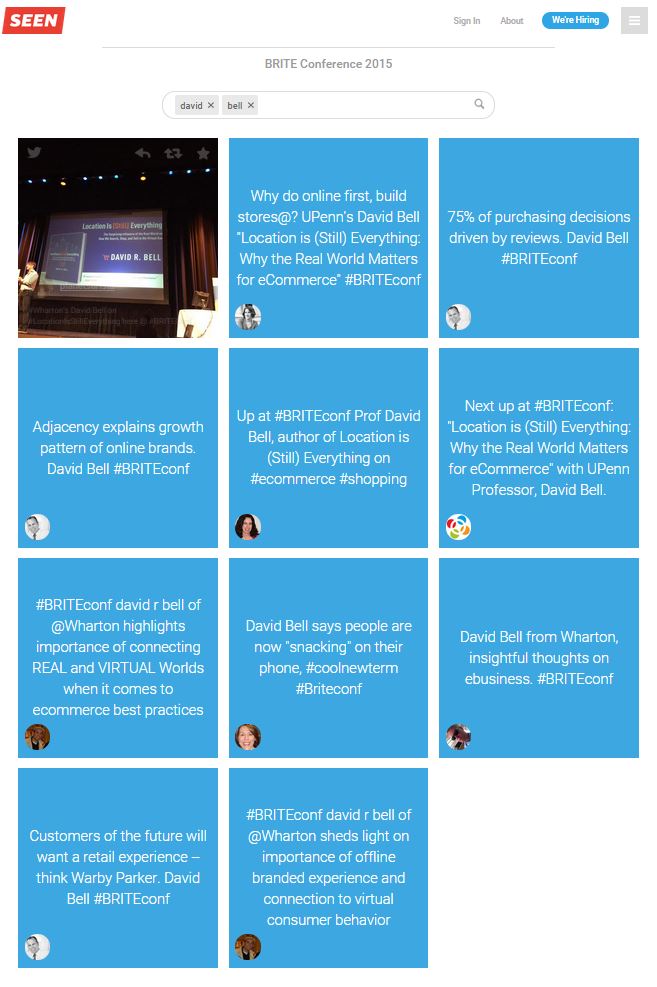 Whether you are a physical retailer or an ecommerce based one, location matters. That's according to David R. Bell from Wharton, author of Location is (still) everything: why the real world matters for e-commerce, who presented findings from his book at #BRITEconf 2015. Note, though, that it's location with a twist: think location of the customer.
Whether you are a physical retailer or an ecommerce based one, location matters. That's according to David R. Bell from Wharton, author of Location is (still) everything: why the real world matters for e-commerce, who presented findings from his book at #BRITEconf 2015. Note, though, that it's location with a twist: think location of the customer.
From the book description,
"...The way we use the Internet is still largely shaped by the physical world we inhabit.
The examples he uses are of businesses which began online (e.g., Warby Parker, Bonobos, Birchbox, Amazon...) and have since launched physical locations. In so doing, they have redefined the customer experience and created memorable and buzz-worthy destinations. As When Does the ‘Human Touch’ Matter in Retail? (which quotes Bell) says about these retailers,
"They are reinventing the customer experience with smaller, more intimate spaces, focusing on delivering a special experience in addition to displaying products."
Why Customer Location Matters
In Why Location is King for E-commerce, Too, Bell describes highlights from his research.
"it’s very critical to understand what the offline environment looks like. Why is it that you have some customers in one location and no customers in another? What is it about the physical world that is affecting what is going on in the virtual world?"
"Up to half of the new customers that came into the firm that we studied got there because the information was shared from one customer to another in an offline environment."
"For products that are not naturally socially visible, then maybe there is a way to make it socially visible by having it shipped to the office rather than the home, for example."
"...You really need to operate both online and offline. There are certain things that the online environment does for you — it makes fulfillment easy, it makes it easy to scale. But there are other critical things that offline does for you, as well. It makes it much easier to relay information to other people. It also makes it much easier to build credibility about your brand if you really have a physical world presence."
"But what we’re finding is that it’s still about location, but this time it’s about the location of the customer. Where is that customer and with whom does that customer also live? That’s what’s really important in the world of e-commerce."
How GRAVITY Relates to Customer Location
GRAVITY is both metaphor and framework for the book, says Bell. It helps to explain shopping patterns and the importance of location.
- Geography
- Resistance
- Adjacency
- Vicinity
- Isolation
- Topography
- You
According to Bell, the real world still shapes commerce since we are selling to people in the real world and need to understand it. Where we live and our offline behavior influences our online behavior. (Reminds me of the importance of walking in our customers' shoes and truly understanding our buyer personas and their pain points.)
- Lots of sharing happens offline, based on trust and neighborhood interactions. That is the essence of social interaction. When you make things socially visible, it's easier to share them. Digital can help you amplify.
- Offline location defines your offline possibilities. Offline makes sharing information easier; builds credibility.
Geography Case Study Example: Diapers.com
Bell showed us a map of the US illustrating the pattern of client acquisition for Diapers.com . After 42 months, the entire US was covered. New customers were acquired close to where previous customers came from.
1st driver = HOMOPHILY (love of the same)
2nd driver = contagion (Birchbox, for example, delivers to offices because they can gain greater social exposure. See Why Location Is (Still) Everything.)
Resistance Case Study Example: Milo.com
75% of every decision driven by reviews (even though 30% are fake). To overcome Resistance, Milo.com embraced transparency. Travelocity does the same.
Adjacency Case Study Example: Crate & Barrel
Crate& Barrel – a traditional retailer - wanted to learn what would happen when it offered customers the option to buy online/pickup in store. This was activated in certain stores only. It found that online sales went down 7%; cart abandonment increased 1%; store sales increased 6%.
Essentially, these were products with non digital attributes which affected the desire to experience them instore.

Vicinity Case Study Example: Warby Parker
Warby Parker – started online first, then ventured into real world. (See How Digital-Physical Mashups Affect Inbound Marketing and Retail.) have sold over 1 million glasses and have been named the No.1 brand by FastCo 2015. They set out to make glasses available at an affordable price (why should glasses cost more than an iPhone?) and figured out how to eliminate friction in the product purchase process by offering online sampling free - 5 frames for 5 days 100% free.
With the addition of showrooms and trendy stores/co-showroom, Warby Parker has seen total demand go up 9%. Where physical store were introduced, 3.5% increase in sales on the web. Although home try-on sales were down 5% (and orders went down 8%) and repeat of home try-ons went down 1.5%, web returns decreased 1.2%. Physical locations increased overall efficiency.
Topography Example
Topography has to do with integrating offline and online. Online is big megaphone for offline and Warby Parker has done clever programs. For example, they did a stunt at the New York Public library with book titles featuring the names of the glass frames. See Warby Parker Takes Over the New York Public Library.
(Connecting With Customers In A World of Demand: Doritos At #BRITEconf 2015 illustrates Topography, too, no?)
How You Might Embrace Location to Improve Your Customer Experience
Do you fully understand what physical influences affects your customers' decision making process?
Can you do more to integrate offline with online? Can you improve your business efficiency via online while reinventing your retail customer experience to be more experiential and memorable for customers?
Can you create greater transparency for customers around your business?
Have you noticed patterns in how you acquire customers?
What else comes to mind?







